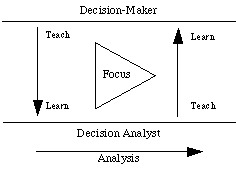The Decision Analysis
Process

A decision analysis is a conversation about a decision situation that
leads the decision-maker to action. The goal of the analysis is to provide
insights into the entire decision situation, which is much more than obtaining
just a numeric answer. In fact, decision analysis often serves other purposes
besides identifying the best course of action. It may help structure information,
create new alternatives, install decision-making mechanism or procedure
and so on.
The decision problems that corporations have to deal with are often
very opaque. Decision analysts apply a sequence of transparent steps to
provide insight into the problem.

Formulation Phase
The activity in the formulation phase addresses the question: "What is
the decision?" In order to answer this question, it is necessary to answer
the following four questions:
"Which problems will be addressed in this analysis?" - determines the
scope of the analysis.
"What choices do we have?" - determines the alternatives
that exist. Also at this stage the analysis may yield new alternatives
that have not been considered before.
"What makes the choice difficult?" - determines the uncertainties
that affect the outcome of the decision.
"What is the criteria that we are going to apply when making a choice?"
- determines the decision-maker's preferences.
Evaluation Phase
The activity in the formulation phase addresses the question: "What is
the recommended alternative?" The activity in this phase can be separated
into deterministic and probabilistic analysis.
Deterministic Analysis
In order to estimate the value of each existing alternative it is necessary
to construct a Business Value Model. This model
estimates the financial value for each possible outcome of the decision
situation.
Deterministic Sensitivity Analysis
identifies the uncertain factors that have the largest effect on the uncertainty
in the value of each alternative. It is also called SenSitivity to
Ranges.
Probabilistic Analysis
The analyst can determine the Probability Distribution
of value to illustrate the risk associated with each alternatives.
The best alternative is the one that has the highest expected utility.
The expected utility measure takes into account not only the expected value
of the alternative, but also the decision-maker's risk and time preferences.
Appraisal Phase
The activities in this phase answer the question: "Why should the recommended
alternative be implemented?" Here more sensitivity
analysis is performed to evaluate the robustness of the recommendation.
The decision analyst may calculate the Value of Information
for critical uncertainties.
Interaction Between Decision-Makers
and Decision Analyst
In the beginning of the dialog, the analyst has to learn about client's
business and the problem at hand. The decision-maker plays the role of
a teacher, communicating the details of the problem and relevant technical
and operational information to the analyst. As the analysis progresses,
the analyst focuses on most important aspects of the problem and gains
insight into the problem and client's business. In the second part
of the dialog, the roles shift: the analyst plays the role of teacher,
presenting the recommended action, and pointing out the important insights
into the client's business.

More on the Decision Analysis Process
Some analysts view the Decision Analysis Process as consisting of two cycles:
Deterministic and Probabilistic.
First, the problem is formulated and solved as deterministic.
This can be achieved by setting unknown variables to some feasible values.
Such analysis points out the variables that "drive the decision" - influence
the resulting value the most. Sometimes the Deterministic Analysis
will point out the course of action that is the best regardless of the
uncertainty. In this case it is said that the alternative "deterministically
dominates" other alternatives.
Then the problem is re-formulated taking into consideration the results
of the Deterministic Analysis. As a result, some variables will be
treated as known and others will be examined more closely. This information
is incorporated into the Value Model and evaluated. The evaluation
of this model yields the probabilistic distribution of the expected utility.

More experienced decision analysts may not have a strict structure to
their decision process. They will use various tools according to
the specific problem and situation.

 Next to Business Problem
Next to Business Problem



